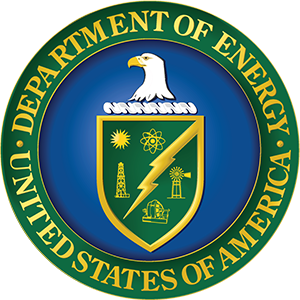Overview
Within This Page
Buildings use nearly 40% of America's overall annual energy consumption, and 75% of the electricity demand. Furthermore, buildings account for 30% of the total carbon dioxide (CO2, which is the primary greenhouse gas associated with atmospheric warming), 49% of the sulfur dioxide, and 25% of the nitrogen oxides emitted in the U.S. (Source: EPA)
A majority of energy used in buildings is still from non-renewable, fossil fuel resources. However, the building sector also has the highest potential for energy efficiency. With rising demand for fossil fuels coupled with uncertainty over the availability of fossil fuels in the future, rising concerns over energy security (both for general supply and specific needs of facilities), and the potential that buildup of greenhouse gases may be causing undesirable impacts on the global climate, it is essential to find ways to reduce load, increase efficiency, and utilize renewable energy resources in all types of facilities.
During a building's design and development, apply a comprehensive, integrated approach to the process, to:
- Reduce heating, cooling, and lighting demand through passive strategies such as climate-responsive design, daylighting, and conservation practices;
- Specify efficient HVAC and lighting systems that consider part-load conditions and utility interface requirements;
- Employ renewable energy sources such as solar heating for hot water, photovoltaics, geothermal space heating, and groundwater cooling, sized for the reduced building loads;
- Optimize building performance by employing energy modeling programs during design;
- Optimize system control strategies by using occupancy sensors, CO2 sensors, and other air quality alarms during operation;
- Monitor project performance through a policy of commissioning, metering, annual reporting, and periodic re-commissioning;
- Consider Retrocommissioning of buildings which were never originally commissioned; and
- Integrate water saving technologies to reduce the energy burden of providing potable water.
Apply this process to the reuse, renovation or repair of existing buildings as well.
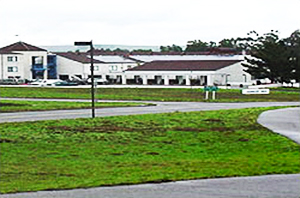
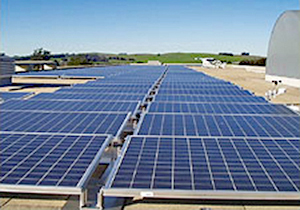
U.S. Coast Guard (USCG) Training Center in Petaluma, California. An ASLA Award Recipient. Photo Credit: Nancy Rottle
Recommendations
Reduce Heating, Cooling, and Lighting Loads through Climate-Responsive Design and Conservation Practices
- Use passive solar design; orient, size, and specify windows to balance daylighting versus heat loss; and locate landscape elements with solar geometry and building load requirements in mind.
- Use high-performance building envelopes; select walls, roofs, and other assemblies based on long-term insulation, air barrier performance, and durability requirements.
- Consider an integrated landscape design that provides deciduous trees for summer shading, appropriate planting for windbreaks, and attractive outdoor spaces so that occupants wish to be outdoors—thereby reducing the occupant-driven additional heat loads to the building.
Specify Efficient HVAC and Lighting Systems
- Use energy efficient HVAC equipment and systems that meet or exceed 10 CFR 434. For Department of Defense buildings, refer to the standards within UFC 1-200-02 High Performance and Sustainable Building Requirements.
- Incorporate strategies to reduce excessive air changes and use energy recovery systems for makeup air.
- Introduce combustion air strategically into the building enclosure for mechanical equipment by using sealed combustion or ducted systems rather than simple louvered wall openings.
- Use lighting systems that consume less than 1 watt/square foot for ambient lighting.
- Use Energy Star® approved and/or FEMP-designated energy efficient products or products that meet or exceed Department of Energy standards.
- Evaluate energy recovery systems that pre-heat or pre-cool incoming ventilation air in commercial and institutional buildings.
- Investigate the use of integrated generation and delivery systems, such as co-generation, fuel cells, and off-peak thermal storage. See also WBDG Distributed Energy Resources (DER) and Microturbines.
Employ Renewable or High-Efficiency Energy Sources
- Renewable energy sources include solar water heating, photovoltaic (PV), wind, biomass, and geothermal. Use of renewable energy can increase energy security and reduce dependence on imported fuels, while reducing or eliminating greenhouse gas emissions associated with energy use. Consider solar thermal for domestic hot water and heating purposes.
- Evaluate the use of building scale to take advantage of on-site renewable energy technologies such as solar water heating, and geothermal heat pumps.
- Consider the use of larger scale, on-site renewable energy technologies such as photovoltaics, solar thermal, and wind turbines.
- Evaluate purchasing electricity generated from renewable sources or low polluting sources such as natural gas.
Optimize Building Performance and System Control Strategies
- Employ energy modeling programs early in the design process.
- Evaluate the use of modular components such as boilers or chillers to optimize part-load efficiency and maintenance requirements.
- Use sensors to control loads based on occupancy, schedule and/or the availability of natural resources such as daylight or natural ventilation during building operations.
- Provide HVAC night and weekend setbacks where applicable to reduce heating and cooling loads when the building is unoccupied.
- Evaluate the use of Smart Controls that merge building automation systems with information technology (IT) infrastructures.
- Employ centralized remote meter reading and management to provide accurate analysis of energy use and monitor power quality.
- Use metering to confirm building energy and environmental performance through the life of the project.
- Use a comprehensive, building commissioning plan throughout the life of the project.
- Employ an interactive energy management tool that allows you to track and assess energy and water consumption like the Energy Star® Portfolio Manager.
- Provide electronic interactive graphic dashboards in prominent locations to educate occupants of their building's energy and water consumption and highlight sustainable building features.
- See also WBDG Facility Performance Evaluation.
Deep Energy Retrofits
A deep energy retrofit is a whole-building analysis and construction process that achieves much larger energy cost savings than those of simpler energy retrofits such as upgrading lighting and HVAC equipment. In taking a whole-building approach, deep energy retrofits address many systems at once by combining energy efficient measures such as energy-efficient equipment, air sealing, moisture management, controlled ventilation, insulation, and solar control. Resources available to identify deep energy retrofit design opportunities are available from the Rocky Mountain Institute® and Advanced Energy Retrofit Guides are available from the Department of Energy, Office of Energy Efficiency & Renewable Energy.
Sustainability and Energy Security
Energy independence and security are important components of national security and energy strategies. Today, power is mostly generated by massive centralized plants, and electricity moves along transmission lines. Energy independence can be achieved, in part, by minimizing energy consumption through energy conservation, energy efficiency, and by generating energy from local, renewable sources, such as wind, solar, geothermal, etc. (see WBDG Distributed Energy Resources, Fuel Cell Technology, Microturbines, Building Integrated Photovoltaics (BIPV), Daylighting, Passive Solar Heating) Additionally, using distributed energy systems adds to building resiliency as the threats of natural disaster damage become more frequent.
Cyber Security
Building automation systems (BAS), Industrial Control Systems (ICS) and Supervisory Control and Date Acquisition (SCADA) are vulnerable to attack through the Internet. Cyber criminals can access these systems to disable controls disrupt energy and water systems and even destroy equipment. Ensure these systems are protected from these intrusions by employing cyber security measures.
Related Issues
Net Zero Energy Buildings, Campuses, and Communities. The U.S. Department of Energy in collaboration with the National Institute of Building Sciences recently released a common definition for a "zero energy" building, also referred to as a "net zero energy" or "zero net energy" building. This common definition for a zero energy building states that a Zero Energy Building is "an energy-efficient building where, on a source energy basis, the actual annual delivered energy is less than or equal to the on-site renewable exported energy." This definition also applies to campuses, portfolios, and communities. In addition to providing clarity across the industry, this new DOE publication provides important guidelines for measurement and implementation, specifically explaining how to utilize this definition for building projects.
There are also commercial building and residential programs promoting net-zero energy. Examples of commercial, residential, and government net-zero energy buildings can provide guidance for the development of future net-zero energy buildings.


Canada's largest Net Zero Energy building, the Joyce Centre for Partnership and Innovation at Mohawk College, designed by B+H and McCallum Sather Architects, embodies environmental technologies aimed at reducing the building's carbon footprint. The Joyce Centre is one of 16 pilot projects selected by the Canada Green Building Council's Zero Carbon Building Standard to demonstrate Mohawk's vision to be a center for environmental leadership. Photo Credit: Ema Peters, B+H Architects
Combined heat and power (CHP). CHP or cogeneration, is the simultaneous generation of useful mechanical and thermal energy in a single, integrated system. Consider CHP at project onset to increase industrial efficiency and decrease unnecessary fuel consumption. CHP has the ability to divert renewable energy to critical infrastructure.
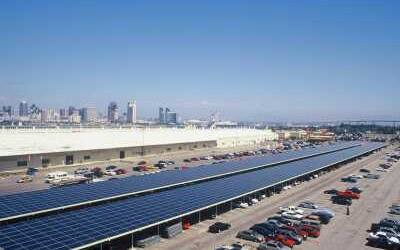
Roof-mounted PV on carport, North Island Naval Base, San Diego, California
Micro-grids. As per the National Electrical Manufacturers Association (NEMA) a micro-grid is an interconnected set of electricity sources and loads that falls under a common method of control. Micro-grids typically integrate small-scale renewable energy generation like photovoltaics (PV) with natural gas turbines and even fuel cells. With the potential disruption of power due to man-caused and weather-related events to critical facilities like hospitals, data centers, and laboratories, micro-grids can provide islanding to insulate facilities from outages. University campuses and military bases can also benefit from micro-grids.
Emerging Issues
Passive survivability, which is described as the ability of a facility to provide shelter and basic occupant needs during and after disaster events without electric power is becoming a design strategy to consider, particularly in areas of the country where storms and floods have been reoccurring annually or more often. Incorporate facility survivability concepts in the design of critical facilities, including on-site renewable energy sources that will be available to power the building soon after a major storm passes.
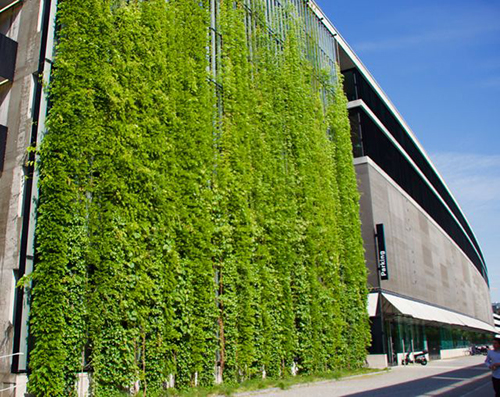
A cable-supported vertical green wall installed on the facade of a building in Switzerland. Photo Credit: LivingRoofs.org
Green Walls and Vertical Gardens, or Living Walls, are used as a sustainable design element in many buildings. The plants naturally take in carbon dioxide and other pollutants and then expel fresh, clean oxygen. These walls also help dampen noise and provide benefits connected to biophilic design. Be sure they do not conflict with site security requirements including Crime Prevention Through Environmental Design (CPTED).
Relevant Codes, Laws, and Standards
Codes and Laws
- Energy Codes and Standards, WBDG Resource Page
- Energy Independence and Security Act of 2007
- Energy Policy Act of 2005 (EPACT)
- Executive Order 13221, "Energy Efficient Standby Power Devices"
- Executive Order 13834, "Efficient Federal Operations"
- International Green Construction Code (ICC IgCC), International Code Council
Standards
- ASHRAE 90.1 Energy Standard for Buildings Except Low-Rise Residential Buildings
- ASHRAE 100 Energy Efficiency in Existing Buildings
- PBS-P100 Facilities Standards for the Public Buildings Service, General Services Administration (GSA)
- UFC-1-200-02, High Performance and Sustainable Building Requirements
Additional Resources
Minimize Energy Consumption
- ASHRAE Advanced Energy Design Guides
- Energy Star®, EPA
- Energy Star® for New Building Design
- Federal Energy Management Program (FEMP), DOE
- Federal Research and Develop Agenda for Net-Zero Energy, High-Performance Green Buildings , National Science and Technology Council Report. October 2008.
Employ Renewable or High-Efficiency Energy Sources
- Guide to Integrating Renewable Energy in Federal Construction, Federal Energy Management Program (FEMP)
- National Renewable Energy Laboratory (NREL)
- Sandia National Laboratory, Photovoltaics
Specify Efficient HVAC and Lighting Systems
- 10 CFR 434 Subpart A
- FEMP Energy Efficient Product Procurement
- Lighting Research Center
- Technology Performance Exchange™—TPEx allows building users, product manufacturers, and third-party certifiers to access, share, and compare performance data for products and systems using an online tool. National Renewable Energy Laboratory (NREL)
Optimize Building Performance and System Control Strategies
- Buildings R&D Breakthroughs: Technologies and Products Supported by the Building Technologies Program , Department of Energy (DOE). April 2012.
- International Performance Measurement and Verification Protocol (IPMVP) Volume 1 , Department of Energy (DOE). March 2002.
- Building Energy Information Systems: State of the Technology and User Case Studies , Lawrence Berkeley National Laboratory. November 2009.
Deep Energy Retrofits
- Advanced Energy Retrofit Guide for Office Buildings, DOE
- Advanced Energy Retrofit Guide for Retail Buildings, DOE
- Advanced Energy Retrofit Guide for Grocery Stores, DOE
- Advanced Energy Retrofit Guide for K–12 Schools, DOE
- Advanced Energy Retrofit Guide for Healthcare Facilities, DOE
- Guide to Building the Case for Deep Energy Retrofits, 2012. Rocky Mountain Institute (RMI)
- Guide: Managing Deep Energy Retrofits, 2012. Rocky Mountain Institute (RMI)
- Guide: Identifying Design Opportunities for Deep Energy Retrofits, 2012. Rocky Mountain Institute (RMI)
- International Energy Agency: Annex 61 Business and Technical Concepts for Deep Energy Retrofits of Public Buildings
Others
- Army Net Zero—Resources for Net Zero energy, water and waste
- Army Vision for Net Zero, Army Energy and Water Management Program
- Department of Defense 2014 Climate Change Adaptation Roadmap
- FedCenter.gov—FedCenter, the Federal Facilities Environmental Stewardship and Compliance Assistance Center, is a collaborative effort between the Office of the Federal Environmental Executive (OFEE), the U.S. Army Corps of Engineers Construction Engineering Research Laboratory, and the U.S. EPA Federal Facilities Enforcement Office, a one-stop source of environmental stewardship and compliance assistance information focused solely on the needs of federal government facilities.
- RenewableEnergyWorld.com
- White Paper: Combined Heat and Power for Industrial Revitalization Center for Clean Air Policy (CCAP). July 2013.
Tools
- Building Performance Database, Office of Energy Efficiency and Renewable Energy (EERE)
- GSA Sustainable Facilities Tool (SFTool)—SFTool's immersive virtual environment addresses all your sustainability planning, designing and procurement needs.



